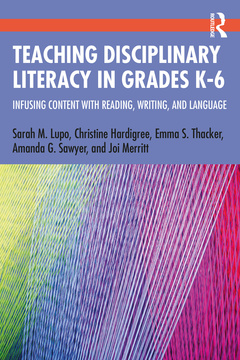Teaching Disciplinary Literacy in Grades K-6 Infusing Content with Reading, Writing, and Language
Auteurs : Lupo Sarah, Hardigree Christine, Thacker Emma, Sawyer Amanda, Merritt Joi

Accessible and engaging, this text provides a comprehensive framework and practical strategies for infusing content-area instruction in math, social studies, and science into literacy instruction for grades K-6.
Throughout ten clear thematic chapters, the authors introduce an innovative Content-Driven Integration (CDI) model and a roadmap to apply it in the classroom. Each chapter provides invaluable tools and techniques for pre-service classroom teachers to create a quality integrated thematic unit from start to finish. Features include Chapter Previews, Anticipation Guides, Questions to Ponder, Teacher Spotlights, "Now You Try it" sections, and more. Using authentic examples to highlight actual challenges and teacher experiences, this text illustrates what integrating high-quality, rich content-infused literacy looks like in the real world. Celebrating student diversity, this book discusses how to meet a wide variety of students? needs, with a focus on English Language Learners, culturally and linguistically diverse students, and students with reading and writing difficulties.
A thorough guide to disciplinary integration, this book is an essential text for courses on disciplinary literacy, elementary/primary literacy, and English Language Arts (ELA) methods, and is ideal for pre-service and in-service ELA and literacy teachers, as well as consultants, literacy scholars, and curriculum specialists.
1. Bringing Science, Social Studies, and Math into the Literacy Block 2. Zooming Out on the Holistic Goals of Literacy Instruction 3. The Content-Driven Integration Model for Developing Thematic, Interdisciplinary Units 4. Selecting Texts for Integrated Instruction 5. Reading to Learn: Bringing Reading Instruction and Content Learning Together 6. Writing to Learn 7. Analyzing Texts to Support Comprehension 8. Developing Vocabulary 9. Talking to Learn… and Learning to Talk 10. Supporting Students With Process-Based Writing
Sarah M. Lupo is an Assistant Professor of Literacy Education in the Early, Elementary, and Reading Education Department at James Madison University, USA.
Christine Hardigree is an Assistant Professor of Adolescent Literacy Education in the Education Department at Iona College, USA.
Emma S. Thacker is an Associate Professor of Social Studies Education in the Early, Elementary, and Reading Education Department at James Madison University, USA.
Amanda G. Sawyer is an Associate Professor of Mathematics Education in the Middle, Secondary, and Mathematics Education Department at James Madison University, USA.
Joi D. Merritt is an Associate Professor of Science Education in the Early, Elementary, and Reading Education Department at James Madison University, USA.
Date de parution : 09-2021
17.8x25.4 cm
Date de parution : 09-2021
17.8x25.4 cm
Thèmes de Teaching Disciplinary Literacy in Grades K-6 :
Mots-clés :
Content Learning Objectives; Literacy Block; disciplinary literacy; C3 Framework; instructional model; Common Core ELA Standard; critical thinking skills; Partial Alphabetic Readers; core standards; Support Students; elementary education; CCSSO; content area literacy; ELA; primary education; Pacific Cod; English language arts; Interdisciplinary Unit; STEM; Interdisciplinary Thematic Units; science; Social Studies Goal; maths; Probable Passage; ELLs; Social Studies Content; ESL students; Read Aloud; sample lessons; Informational Texts; instruction; Anticipation Guide; writing; Social Studies; language development; Graphic Organizers; Literacy Learning Objectives; Se Puede; Literacy Goals; Social Studies Standards; Multilingual Learners; Hopper’s Students


